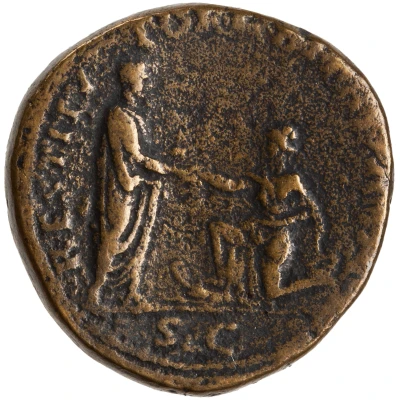


© American Numismatic Society (ANS)
Sestertius - Hadrian RESTITVTORI BITHYNIAE S C; Bithynia
| Orichalcum | 25 g | 32.5 mm |
| Issuer | Rome › Roman Empire (27 BC - 395 AD) |
|---|---|
| Emperor | Hadrian (Publius Aelius Hadrianus) (117-138) |
| Type | Standard circulation coin |
| Years | 130-133 |
| Value | 1 Sestertius = ¼ Denarius |
| Currency | Denarius, Reform of Augustus (27 BC – AD 215) |
| Composition | Orichalcum |
| Weight | 25 g |
| Diameter | 32.5 mm |
| Shape | Round (irregular) |
| Technique | Hammered |
| Demonetized | Yes |
| Updated | 2024-10-06 |
| Numista | N#256320 |
|---|---|
| Rarity index | 100% |
Reverse
Hadrian standing right, holding scroll and raising kneeling Bithynia, holding acrostolium and resting foot on prow.
Script: Latin
Lettering:
RESTITVTORI BITHYNIAE
S C
Translation:
Restitutori Bithyniae. Senatus Consultum.
To the restorer of Bithynia. Decree of the senate.
Comment
Source: Online Coins of the Roman Empire (OCRE)Interesting fact
One interesting fact about this coin is that the metal used to make it, orichalcum, is a mysterious and rare alloy that was highly valued in ancient times. The exact composition of orichalcum is unknown, but it is believed to be a mixture of gold, silver, and other metals. The use of orichalcum in the production of coins was reserved for special occasions, such as the issuance of commemorative coins, and its durability and resistance to corrosion made it an ideal material for coinage.